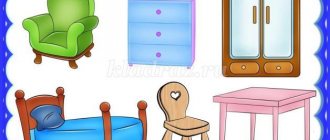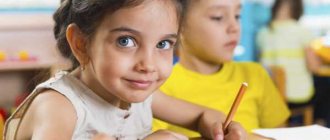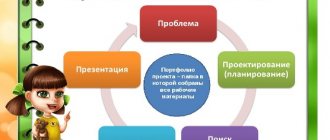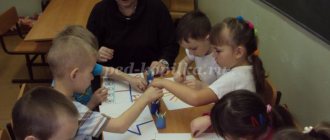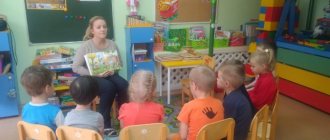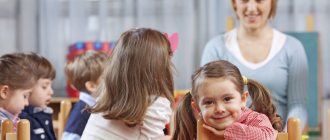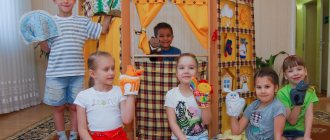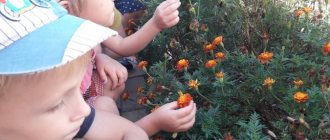Productive activities for preschool children
Productive activity of preschoolers is the right direction in preparing the future first-grader for education.
The formation, development and formation of a child’s personality is one of the most relevant, important and responsible areas of activity for specialists involved in the field of pedagogy and child psychology. One of the main tasks that must be constantly performed in this direction is the use of various styles, forms and methods, including productive activities.
Contents and types of productive activities in the senior preschool group of preschool educational institutions
Definition 1
Productive activity is the performance of types of work that occupy a central place in the life of a preschooler and are of a modeling nature (modeling, artistic creativity, design, appliqué).
Such productive activities of preschoolers are focused on creating models of real-world objects in various ways. This helps to reveal the child’s creative potential, develop his intellect, activate his work skills, develop imagination and memory.
Engaging in productive activities is especially relevant in older preschool years. At this time, the child is preparing for school, mastering the structure of the world. Therefore, the development of memory and intelligence is simply necessary to prepare for the new stage of his life.
Are you an expert in this subject area? We invite you to become the author of the Directory Working Conditions
Productive activity is based on developing the child’s creative skills. He takes some materials and creates a new real product from them. Perhaps this product will not turn out to be useful and will not be used in real life, but experience, work skills, and creating something with one’s own hands develop the creative direction of his future activities.
In the course of implementing various areas of productive activity, the child masters the skills of using various tools and the ability to use resources to create the final product. These skills will be useful to him in everyday life, education and other activities.
Productive activities in preschool educational institutions are implemented in the form of special classes, the topics of which are focused on the formation of specific creative skills and the disclosure of specific creative abilities. Such classes are not differentiated, i.e. The topic is chosen the same for everyone and the teacher does not differentiate the completion of tasks according to the preferences of the children, i.e. One child cannot sculpt and another can draw an elephant. It is necessary to teach each child how to use plasticine and how to sculpt various objects from it.
Finished works on a similar topic
Course work Organization of productive activities in a preparatory group for school 470 ₽ Abstract Organization of productive activities in a preparatory group for school 270 ₽ Examination Organization of productive activities in a preparatory group for school 220 ₽
Receive completed work or specialist advice on your educational project Find out the cost
Note 1
To make the work individually oriented, it is necessary to choose the topic of the lesson and its content based on the capabilities and interests of the children. A productive activity should solve developmental problems and realize the interests of children.
Productive activity can be implemented according to the principle of one of the types of activity:
- Sample activities. The work is carried out according to a specific scheme. As a rule, there is a visual example of the creation of the final product and children, following the instructions step by step, create it.
- Activities with unfinished products. There is some object, for example, a drawing or design, which is not completed and needs to be completed (finish the ears of an elephant, complete the assembly of a house, etc.).
- Activities using graphic diagrams. There is a diagram showing the sequence of actions and options for their implementation. It implements step-by-step productive work.
- Activities to verbally describe the intended purpose and conditions of implementation. The teacher tells the children what and how they need to do, indicating the existing conditions for creating the product, materials and tools that can be used.
Productive work of all types is developmental in nature. The child receives a charge of emotions, activates the imagination, develops initiative, strives to assert himself as a creator of something, learns to manage his emotions, trains the will, and develops responsibility.
Figure 1. Types of productive activities. Author24 - online exchange of student work
In addition, productive activity develops the child’s motor skills, which is good for speech development.
Important
Productive activities of children play one of the main roles in the process of comprehensive development of a preschooler. Along with the game type, they constitute a single complex of work on preschool education, carried out under the guidance of adults (teachers, educators). The result of this activity should be a specific product.
Numerous studies conducted by specialists in different parts of the world and with different categories of children who have not yet reached primary school age have shown the effectiveness of productive activities among this age group of children.
A beneficial effect on preschoolers has been established in the development of graphic skills, as well as the development of perseverance and determination in mastering important skills.
Summary of productive (constructive) direct educational activities. Middle group
Summary of productive (constructive) direct educational activities on the topic “Bus for children”
Author: Oksana Vasilievna Kokovina, teacher, MBDOU “Kindergarten No. 22 of a general developmental type with priority implementation of activities in the artistic and aesthetic direction of children’s development.” Description of the material. The activity is intended to work with children 4-5 years old who are mastering basic techniques of constructive creativity with paper. This activity is final, as it is based on the repetition of such thematic blocks as “Transport”, “Geometric figures”, “Quantitative counting of objects”, “Orientation in space”, “Whole and part” and includes such educational areas as “Cognition ", "Safety", "Artistic creativity". Goals. 1. Develop children’s imagination, the ability to imagine the final result of their work. 2. Cultivate accuracy in productive activities. 3. Teach children to create a bus design from these materials, following the design rules. Objectives: • consolidate children's knowledge of the main types of transport, practice them in recognizing and naming transport based on descriptions and illustrations; • consolidate children’s ability to recognize and correctly name geometric shapes, use quantitative counting of objects in speech, navigate on paper using the adverbs “above”, “below”, and also create a familiar object from separate parts; • organize productive (constructive) activities of children, cultivating accuracy and the ability to finish what they start; continue to teach children to fold the paper in half, glue the wheels, applying glue only to one half of the part (up to the strip). Materials: doll - boy Toropyzhka, easel, flannelograph, illustrations from the “Transport” series, didactic game “Fix the Car” (for use on a flannelgraph), individual appliqué and design kits for each child (half a landscape sheet of colored cardboard, rectangles of white paper for making windows and doors, scissors, glue, napkins for work, 4 circles - black wheels with lines drawn in the middle of the circles on the reverse side, felt-tip pens). Progress of activities. 1. Motivational stage. Children sit on chairs placed in a semicircle, the teacher sits so that he can see everyone.
The teacher draws the children’s attention to the fact that a boy named Toropyzhka has come to visit them. He is always in a hurry everywhere, that’s why his name is Toropyzhka. “And now Toropyzhka is in such a hurry that he forgot to say hello to the guys and is ready to run away somewhere.”
- Oh, forgive me, guys. Hello! And I’m in a hurry to visit my friend Dunno for his birthday. Do you know this one? I invited everyone, and I invite you, and now I’m running. 2. Stage of repetition of the covered material.
- Wait, Toropyzhka, have you prepared a gift for Dunno?
“That’s the problem, I bought him a lot of toys, but when I was running, I dropped them and broke everything.” Now I need a good master. - Wait, Toropyzhka, don’t rush. Our guys will be able to help you. The teacher places parts of toys on a flannelgraph - different types of transport (plane, ship, car, rocket, bicycle) and invites the children to “repair” these toys - to connect them into integral formations.
The teacher invites several children to complete the task, the rest check the correctness of completion. - Oh, thank you guys, you helped me out so much - you fixed all the toys.
And now we will play a game that all the animals from our forest love. The teacher invites the children to stand up and organizes a physical activity called “Animal exercise” (based on the text by A. Barto).
One - squat, two - squat.
This is a hare exercise (we squat)
.
And the little foxes, when they wake up, love to reach for the sky (we stretch our arms up)
, be sure to yawn, and wag their tail
(move their hips from side to side)
.
And for the wolf cubs, arch your back (arms to the sides, bend forward)
and jump
slightly (light jump up)
.
Well, the bear is clubfooted, with its paws spread wide apart, first one, then both together, marking time for a long time (imitating the gait of a bear).
Those who warmed up, played, ran to the stump
(sat down in their seats)
, and for those who don’t have enough exercise, we start all over again.
- Well? Shall we start all over again or will we continue to play with Toropyzhka? - Of course, play! Let's play the game "Riddles - Guessing". I will tell you riddles, and you will tell me the answers. The teacher, on behalf of the doll, asks the children riddles about transport and, if the answer is correct, places the corresponding illustration on the easel.
1) The brothers got ready for a visit, clung to each other, and rushed off on a long journey, only leaving a trail of smoke.
What is this? (Train) 2) Amazing carriage! Judge for yourself: The rails are in the air, and he holds them with his hands. What is this? (Trolleybus) 3) Here is a steel bird striving for the skies, And its pilot is leading it. What kind of bird? (Airplane) 4) The palace floats on the waves, carrying people on it. What is this? (Ship) 5) Doesn’t fly, doesn’t buzz, the beetle runs down the street. And two brilliant lights burn in the beetle’s eyes. What is this? (Car) 6) This horse doesn’t eat oats, instead of legs it has two wheels. Sit on horseback and race on it, but better control the steering wheel. What is this? (Bicycle) 7) A house goes down the street, it takes us to work, not on thin chicken legs, but in rubber boots. What is this? (Bus) - Oh, guys, well done, you solved all the riddles! — Toropyzhka, what kind of transport did you come to us in? Is it really in a hot air balloon? - I came to you on the bus. Look what it is like (the teacher removes all illustrations of modes of transport from the easel, leaving only the bus, then on behalf of Toropyzhka talks about it, showing its parts)
: it has a large cabin with seats for passengers and the main seat for the driver.
There is always a steering wheel in front of this chair. The cabin has doors and many windows, and the driver has the most important window, it is the largest. Below it are two headlights - large lanterns that illuminate the driver's road in the dark. And the bus stands on four large and soft wheels. Without them, no bus can travel. This is what it is - a bus. - Now it’s time for us to go. But, guys, the Flower City of Kids is not an ordinary city where regular buses travel, but a fabulous one. That’s why our buses are fabulous. Look, here is my bus - it looks like a real one, only made of cardboard. This bus was built for me by Vintik and Shpuntik. And the teacher shows the children the finished design of the bus.
— Look, guys, what a wonderful bus!
It is made of cardboard. What geometric figure does a bus cabin resemble? And his windows? Wheels? Let's count how many wheels the bus has. How many windows does it have? Children look at the finished bus design and answer the teacher’s questions.
- Guys, come on, let’s make such a bus!
Although it is not big, if each of us makes a bus, then we can all go together to Dunno’s Birthday. The teacher invites the children to go to the tables where appliqué and design kits have been prepared. 3. Stage of productive (constructive) activity. The teacher invites the children to look at the sets and reminds them of the rules for safe work with scissors and glue. The teacher shows the children the finished bus design and invites them to find parts of their bus in the set.
— Guys, find the part that will become the cabin of your bus.
This is a big rectangle. What needs to be done to create a stable cabin? That's right, bend a piece of cardboard in half. Children bend a piece of cardboard along its length, connecting the corners and smoothing the fold line.
- Now find the parts that will become the windows on your bus.
That's right, these are white rectangles. But they are very long, let's cut them into two equal parts. How to do it? - That's right, you need to fold the rectangles so that their corners match, smooth out the fold line, then unfold and cut along this line. Children complete the task.
- Now count how many windows there will be on our bus.
What shape did they get? But what is a bus without a door! What geometric shape does a bus door resemble? - That's right, a rectangle. Find a rectangle in your kits that will become the door of the bus. - Now find the parts that will become the wheels of the bus. How many are there? What shape are they? The teacher draws the children's attention to the fact that on the back of the circles there is a line drawn dividing the circles into equal halves.
Then the teacher says that the children need to apply glue to only one half of the circle and glue the wheel with this half to the bus cabin. When all four wheels are glued, the effect will be created that the bus is actually standing on wheels. The guys first glue the wheels of the bus, placing them away from each other. The teacher monitors the correct performance of the children’s actions. Then the children glue the door. — Guys, are the windows on the bus located at the top or bottom of the cabin?
Correct, the windows are located above the wheels? Let's glue the windows too. Children complete the task. Then the teacher invites the children to draw with felt-tip pens the children themselves, who are riding on the bus and seem to be looking out the windows. After the children have completed their work, Toropyzhka praises the children, and the teacher arranges chairs in groups of 2-3 and organizes a role-playing game “Ride on the Bus.” 4. Reflection. During the “trip”, the teacher asks the children to remember what they did during the lesson.
Further, joint activities with children can unfold into the plot-role-playing game “Dunno’s Birthday.” These are the buses we got.
We recommend watching:
Development of spatial thinking in 6-year-old children Correctional work with children with special needs in the preparatory group Summary of educational activities with preschoolers in the senior group. Transport Summary of a lesson on developing independent speech (retelling) in the preparatory group. Topic: "Tr
Similar articles:
Games for preschoolers on the topic: Transport
Definition
Productive activities of children are one or another way of a child’s activity, the goal of which is to obtain a product that has a specific set of qualities. This category includes:
- different ways of assembling structures,
- crafts made from plasticine or special clay,
- performing appliqué work, mosaics,
- making various crafts,
- more complex work - certain layouts.
All productive activities of children listed above perform a responsible function for the development of preschoolers. This is the basis of many kindergarten programs designed for children under school age. This program is aimed at their comprehensive development and education.
Comprehensive development
The formation of this type of activity for children takes place in kindergarten under the guidance of experienced specialists. At this time, the connection between the children’s desire to create this or that product and the expansion of their cognitive abilities, various processes and qualities, the emotional area, and the volitional sphere of development is most clearly manifested.
The most vivid and controlled development of children’s character traits occurs, the formation of their character and individuality.
It is also interesting to read what features the speech development of an older preschooler has.
